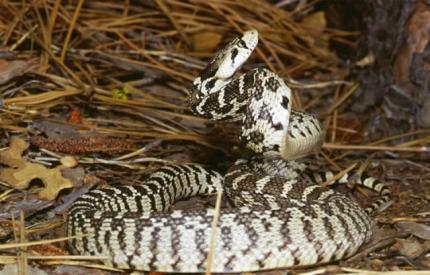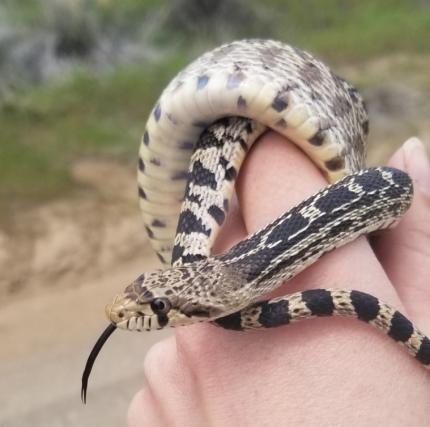These non-venomous snakes are common and widespread in eastern Washington. The species in western Washington is most likely no longer in existence.
According to NatureServe, the state conservation status of the gopher snake population is considered “secure” in Washington.
This snake is often misidentified as a rattlesnake because the two species have similar markings and defensive behavior. Gopher snakes will bite if threatened, but the bite is not venomous. These snakes serve an important function in wildlife communities, preying extensively on small mammals.
Description and Range
Physical description
The gopher snake is a large snake with dark blotches, a distinct eye stripe and a tail that tapers to the tip. Adults can grow to around 6 feet total length in the Northwest. In Washington, they are usually beige or tan with large dark brown or black square-shaped blotches down the back and smaller blotches on the sides. The tail is banded. The dorsal (topside) scales are keeled with 29 to 37 scales at mid-body. The underside is white with black spots on the edges of the ventral scales.
The head is somewhat triangular in shape, becoming more pronounced when the snake is agitated. A distinct eye stripe is present from the edges of the jaw, through the eyes and across the snout. A small dark “tear-like” marking occurs below each eye. The pupils are round.
No obvious external features distinguish males from females. Juveniles resemble adults.
In comparison to rattlesnakes, gopher snakes differ in their physical appearance by lacking a rattle and facial pits. They also have smaller, square, dorsal spots; oval pupils; a narrow eye stripe that extends both to the posterior edge of the jaw and below the eye; and scales that are less keeled.
The gopher snake specimens collected from Puget Sound in the 1800s were a different subspecies (Pacific gophersnake, P.c. catenifer) than those found in eastern Washington (Great Basin gophersnake, P.c. deserticola).
The most obvious features that distinguish the Great Basin gopher snake from the Pacific gopher snake are the dark dorsal blotches that, in the Great Basin subspecies, are connected near the head and the blotches on the side of the neck merge to form lines.
For more details about gopher snake, see the Washington Herp Atlas.
Ecology and life history
In Washington, gopher snakes are primarily a species of dry habitat types such as shrubsteppe, Oregon white oak and ponderosa pine forests. They spend a great deal of time below the surface in animal burrows. They can be active day or night.

In most of the Columbia Basin, gopher snakes emerge from overwintering sites in late March or early April. They are typically one of the first snakes to be found active away from overwintering sites. Young start to appear in late August or early September. Activity continues into late October depending on location and weather conditions.
Gopher snakes exhibit dramatic defensive behaviors including hissing, puffing the body, coiling, flattening the head, vibrating the tail, and striking. This behavior, combined with their general appearance, mimics rattlesnakes. Gopher snakes will bite if threatened, but the bite is not venomous.
These snakes serve an important function in wildlife communities, preying extensively on small mammals.
Geographic range
Gopher snakes occur east of the Cascade Mountains primarily in the Columbia Basin and Okanogan ecoregions. A few occurrences are documented in the East Cascades Ecoregion.
Two gopher snake specimens, collected in the late 1800s from the “Puget Sound”, are housed in the U.S. National Museum, Washington D.C. George Suckley, a physician and naturalist with the Pacific Railroad Surveys 1853 to 1855, reported that the gopher snake (Pacific gopher snake) was “found sparingly at Puget Sound.”
With the exception of a few, scattered individuals of the eastern Washington subspecies, gopher snakes have not been verified present in western Washington since that time. Their historic occurrence in western Washington was likely the result of extensive prairies in the south Puget Sound region. According to NatureServe, the state conservation status of the Pacific gopher snake population is considered “possibly extirpated” in Washington.
This map from the Washington Herp Atlas illustrates the distribution of gopher snake in Washington based on records in the WDFW database as of 2016. If you see this species in areas that are not indicated on the map or have more recent observations (less than 10 years), please share your observation using the WDFW wildlife reporting form. Of particular interest are observations from western Washington, observations that occur outside the known distribution, and recent observation records from Walla Walla County.
For a map of range-wide distribution and conservation status of this species, check out NatureServe Explorer and the International Union for Conservation of Nature Redlist.
Regulations
Licenses and permits
Be advised that collection of this species is only permitted under a WDFW Scientific Collection Permit for research and educational activities.
Conservation

The gopher snake appears to be common and widespread. No major declines have been reported. The state conservation status of the gopher snake is “secure” based on the assumption that it is common according to the most current records.
Unfortunately for gopher snakes, people who mistake them for rattlesnakes often needlessly kill them.
Gopher snakes are particularly easy to find on roads. It is common in the summer to find them basking on roads in the late afternoon and early evening. They exhibit behaviors that make them particularly vulnerable to being killed by vehicles. They tend to bask with their bodies in a straight line and move by inching their way across roads with the body fully extended. When approached, they tend to take a defensive stand (coiling) instead of fleeing to the side of the road.
Living with wildlife
Snakes are among the most misunderstood of all animals. Of the dozen or so species of snakes found in Washington, only the western rattlesnake is capable of inflicting a venomous bite, which it seldom does. All snakes are an important part of the natural food chain, eating a variety of prey—from mice and birds to frogs and insects.
Observe snakes, like all wild animals, from a respectful distance. Learn more about living with snakes.
Resources
References
Hallock, L. A. 1998. Amphibian Inventory of the Cow Creek Watershed, Lincoln and Adams counties, Washington. Unpubl. Rep. Wash. Natural Heritage Program, Dept. of Natural Resources, Olympia. 11 pp. + appendices.
Hallock, L. A. 1998. Herpetofauna of the Hanford Nuclear Reservation, Grant, Franklin and Bentin Counties, Washington. Unpublished report submitted to The Nature Conservancy, Seattle, WA. 43 pp + appendices
Hallock, L. A. 1998. Herpetofauna Inventory of Bureau of Land Management sites in Douglas, Franklin, Grant, Lincoln, Klickitat, Washington. Unpubl. Rep. Wash. Natural Heritage Program, Dept. of Natural Resources, Olympia. 14 pp. + appendices.
McAllister, K. R. 1995 Distribution of Amphibians and Reptiles in Washington State. Northwest Fauna Occasional Monographs on Vertebrate Natural History, Number 3. Society of Northwestern Vertebrate Biology.
Suckley, G. and J.G. Cooper. 1860. The Natural History of Oregon and Washington. Bailliere Brothers, New York. 399 pp.
WDFW publications
WDFW educational resources
- Wild Washington Lesson Plan – Herps in Washington - Elementary school students are introduced to the cold-blooded world of reptiles and amphibians, also known as herps.
- Family Education – Amphibians and Reptiles - Slither, hop, or crawl on over to learn about herpetofauna!